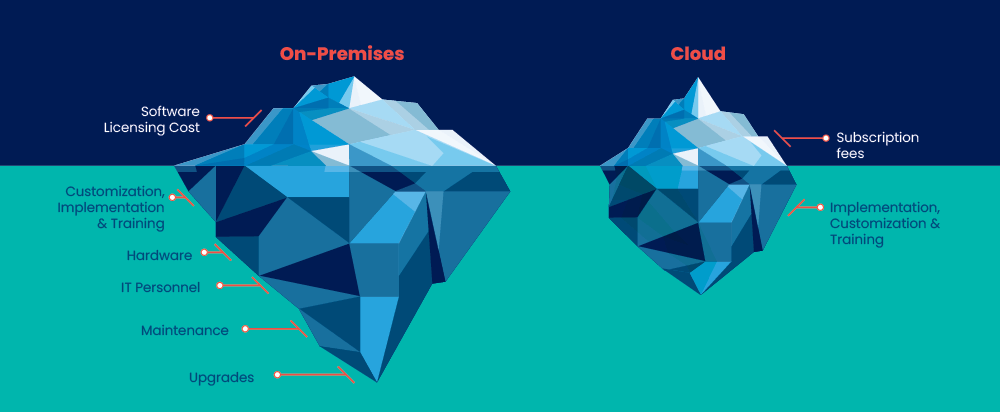Microsoft offers a subscription model for the cloud solutions, so you only have to pay monthly for what you need. Development, support and upgrade costs are lower in the long run than with an on-premise solution. You avoid upfront and ongoing costs for purchased infrastructure, such as servers, operating systems, databases and storage, as well as electricity and other costs. Labor costs for maintenance of the on-premise systems are also eliminated if you switch to the cloud. Your IT specialists no longer need to perform upgrades. In the cloud, you always work with the latest version of the software. This allows IT teams to focus on more value-added tasks.
2. Security first
Many companies are concerned about the security of their data when considering a move to the cloud. However, Microsoft has invested heavily in its Azure platform in recent years in order to maximize security. Microsoft also has a Fixed or Modern Lifecycle Policy for its on-premise products and services. If your products/services are covered by this policy, the end-of-support date is also announced when the product is announced. After the end date, security updates will no longer be available and your data will no longer be optimally protected.
In the following table, you can check the end-of-support date for your on-premise Dynamics products. View all end-of-support dates here .
| |
Mainstream End Date |
Extended End Date |
|---|
| Dynamics CRM 2011 |
07/12/2016 |
07/13/2021 |
| Dynamics CRM 2013 |
01/08/2019 |
01/09/2024 |
| Dynamics CRM 2015 |
01/14/2020 |
01/14/2025 |
| Dynamics CRM 2016 (Dynamics 365) |
01/12/2021 |
01/13/2026 |
Despite the many misconceptions about the security and availability of data in the cloud, there is no need to worry. Microsoft employs several methods to make your data as secure as possible. For example, they use industry-standard encryption protocols, secure networks thanks to the Azure Virtual Network Gateway, and key logs to automate tasks for the required SSL/TLS certificates. There is also built-in protection against malware and threats.
Thanks to multi-factor authentication (MFA) on Azure, you can only log in there if you go through several steps. This requires a password as well as verification via another device or a biometric verification, such as a fingerprint.
Azure’s security center also offers users a range of weapons to keep their cloud solutions secure. In addition to security management and extensive protection options, you can set up security protocols and detect and act on possible hazards. In addition, you also receive useful recommendations for optimizing security.
All your data is stored on secure servers that are distributed around the world. Microsoft guarantees 99.9% uptime. Finally, you can also rely on the fact that, should it ever be necessary, Microsoft can perform "disaster recovery" for you to retrieve your data.
3. Go forward together with access to innovative technologies
By moving to a cloud solution, you are also taking a step towards continuous improvement, faster adaptability and innovation. You can be more flexible and respond faster to the ever-changing circumstances in which we live and work. Those who take the step always have an advantage.
The move can also ensure better business performance and increase employee productivity by ensuring they always have the latest tools. Because Microsoft’s focus in recent years has mainly been on the cloud version of Dynamics 365, users always have access to the most advanced features the Dynamics 365 team is working on. These releases with new functionalities and improvements take place twice a year, in spring and in autumn. This keeps cloud users at the forefront and makes the most of their CRM and ERP solution.
In addition, the impact of the Power Platform should not be underestimated. With this new technology, Microsoft has succeeded in giving companies the opportunity to meet all their business processes and needs with a low code, no code platform. What's more, it uses the same underlying database that is based on your Dynamics365 environment. This means you can use all your data across multiple apps. In addition to building PowerApps, you can easily set up reports and dashboards via PowerBI. Power Automate allows you to automate many things via flows, such as your communications with external parties. The Power Platform is only available online, which is a major weighting in favor of cloud versus on-premise as far as we are concerned.
4. A modern experience adapted to today’s needs
By using Microsoft software in the cloud, you ensure that all your devices and data are constantly linked to each other and to all other tools in the Microsoft ecosystem, such as Microsoft Excel, Office 365, Outlook, etc. By reducing the barriers between the programs you use on a daily basis, you gain a more complete picture of your business and increase productivity. Since everyone always has the same real-time data, decisions can be made quickly - essential to remain competitive.
Dynamics 365’s Unified Interface is Microsoft’s answer to provide a consistent and streamlined user interface across all devices. The cloud provides a consistent and uniform user experience wherever you are.

